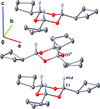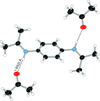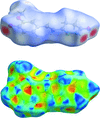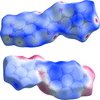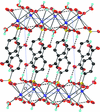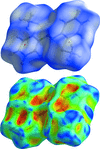issue contents
November 2019 issue

Cover illustration: The title hydrated molecular salt, tetra-n-butylammonium 2,6-dioxo-1,2,3,6-tetrahydropyrimidine-4-carboxylate monohydrate, crystallizes with N-H O and O-H
O and O-H O hydrogen-bonded double-stranded antiparallel ribbons consisting of the hydrophilic orotate monoanions and water molecules, separated by the bulky hydrophobic cations. An accurate structure analysis conducted at T = 100 K is compared to a lower-resolution less accurate determination using data measured at T = 295 K. The structure at room temperature suffers not only from a complex disorder of one terminal ethyl group of the cation, but also produces weak diffraction, to the extent that from intensity statistics we estimate the effective resolution of the data to be about 1.0 Å. The data at T = 100 K are much stronger and give what in present times is regarded as an accurate result, which includes the observation of positive difference density at the centers of most of the bonds not involving H atoms. The results of both analyses were evaluated using a knowledge-based approach, and it was found that the less accurate room-temperature structure analysis provides geometric data that are similar to those derived from the accurate low-temperature analysis, with both sets of results consistent with previously analysed structures. See: Ara, Basdouri, Falvello, Graia, Guerra & Tomás [Acta Cryst. (2019). E75, 1632-1637].
O hydrogen-bonded double-stranded antiparallel ribbons consisting of the hydrophilic orotate monoanions and water molecules, separated by the bulky hydrophobic cations. An accurate structure analysis conducted at T = 100 K is compared to a lower-resolution less accurate determination using data measured at T = 295 K. The structure at room temperature suffers not only from a complex disorder of one terminal ethyl group of the cation, but also produces weak diffraction, to the extent that from intensity statistics we estimate the effective resolution of the data to be about 1.0 Å. The data at T = 100 K are much stronger and give what in present times is regarded as an accurate result, which includes the observation of positive difference density at the centers of most of the bonds not involving H atoms. The results of both analyses were evaluated using a knowledge-based approach, and it was found that the less accurate room-temperature structure analysis provides geometric data that are similar to those derived from the accurate low-temperature analysis, with both sets of results consistent with previously analysed structures. See: Ara, Basdouri, Falvello, Graia, Guerra & Tomás [Acta Cryst. (2019). E75, 1632-1637].
research communications










































Crystal structures of two solvated 2-aryl-3-phenyl-2,3-dihydro-4H-pyrido[3,2-e][1,3]thiazin-4-ones














































 journal menu
journal menu











